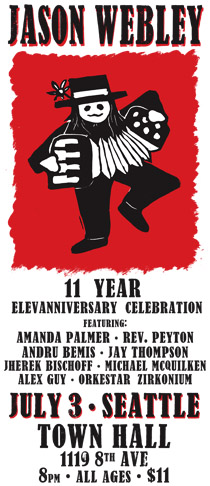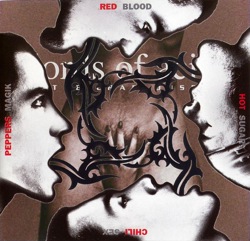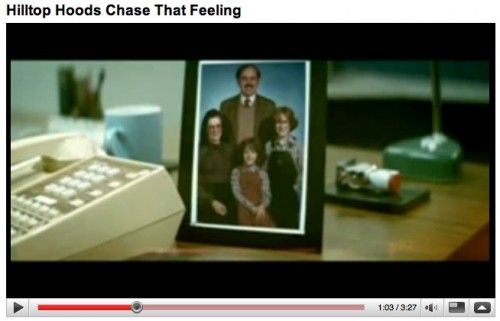 Last night, Prairie and I went out to see Jason Webley’s Elevanniversary show, our first Webley show in a few years. We’d been skipping them lately, but between this being his eleventh anniversary show, having it at Seattle’s Town Hall (a venue we really like), and the guest list he’d lined up, we decided this was one we wanted to see. In the end, while it wasn’t our all-time favorite Webley show, it was still good, (mostly) a lot of fun, and we’re glad we went. I took a few pictures during the course of the night, and they’ll be up eventually, but as we sat towards the back and I was more interested in just enjoying the show, it won’t be among my most comprehensive sets of Webley documentation. I’m sure you’ll all survive. :)
Last night, Prairie and I went out to see Jason Webley’s Elevanniversary show, our first Webley show in a few years. We’d been skipping them lately, but between this being his eleventh anniversary show, having it at Seattle’s Town Hall (a venue we really like), and the guest list he’d lined up, we decided this was one we wanted to see. In the end, while it wasn’t our all-time favorite Webley show, it was still good, (mostly) a lot of fun, and we’re glad we went. I took a few pictures during the course of the night, and they’ll be up eventually, but as we sat towards the back and I was more interested in just enjoying the show, it won’t be among my most comprehensive sets of Webley documentation. I’m sure you’ll all survive. :)
We headed downtown a little early, in order to make sure we got a good parking space close to Town Hall and have time to get dinner before the show. Parking successfully obtained, we wandered down to the Cheesecake Factory for dinner, after stopping off to get a few pictures of what little is left of the Alfaretta Apartments at 8th and Seneca. As crappy as that building was, I liked my little apartment there, and it was where I was living when Prairie and I first met, so it was a little sad to see it reduced to just a few walls and a lot of rubble. After dinner we spent a while wandering around Barnes and Noble, talking each other out of spending money on new books when there are so many good used books available far cheaper, and then headed back up the hill to Town Hall.
There was already a small crowd of people milling about when we returned to Town Hall, and it wasn’t long before a table was set up to process those of us who had will call tickets waiting. (A quick aside: I’ve got to give props, this was by far the most organized and prompt Webley show we’d ever been to. Getting our tickets only took a few minutes, the doors to the lobby actually opened at, and perhaps slightly before, the scheduled 7:30pm, we got into the house and found our seats by 7:45, and the lights dimmed to begin the show at 8:05. Impressive!) Tickets in hand, we waited for the doors to open, and ended up spending a pleasant few minutes chatting with Paco, a burlesque performer from Baltimore who was in town for the weekend to visit Seattle and see the Elevanniversary show.
Once in the auditorium, Prairie and I grabbed seats towards the back of the house on the assumption that most rowdiness would be towards the front, and this would make it easier to dodge overexcited fans later on. As we were all entering and finding our seats, Seattle’s Orkestar Zirkonium was providing entrance music, their euro-klezmer-ish style setting a good tone for the evening to come, as balloons both big and small bounced around the room and Jason’s ever-present goddesses danced and twirled through the aisles.
The show itself was divided roughly in half, with the first half devoted to Jason’s friends and collaborators doing short sets on their own, and Jason coming out for the second half. This ended up having some definite pros and cons: on the plus side, we got some more exposure to the people Jason’s been working with over the past few years, all of whom had quite enjoyable sets; however that also meant that Jason himself had a somewhat abbreviated setlist, and many of the quieter, more introspective songs that Prairie and I enjoy so much were passed over in favor of the louder, more exciting, get-everyone-bouncing-around songs. As fun as those are — and plenty of people were quite rightfully enjoying them — we’re just not quite so bouncy, and missed hearing some of our old favorites. Still, different shows have different intents, and this minor grousing shouldn’t at all be taken to mean that we didn’t enjoy ourselves!
Anyway, the first guest performer up was Andru Bemis, who worked with Jason on the How Big is Tacoma EP, with three of his own songs. Jay Thompson (of Eleven Saints fame) read a few poems for us, then the Rev. Peyton came on (though without his Big Damn Band). Some of Jason’s goddesses did a silly Billy Joel “We Didn’t Start the Fire”-inspred pseudo-retrospective of Jason’s career, accompanied by only a big bass drum. Then the last guest performer, and for many people in the audience the most eagerly anticipated, Amanda Palmer, of both Dresden Dolls and solo fame, not to mention her work with Jason and Evelyn Evelyn.
After Amanda’s set, we were treated (after some slight technical issues) to a short, four-minute edit of video from Jason’s first public performance from eleven years ago, featuring songs from his first album, Viaje. It was fun to see — younger, shorter hair, a bit more unfinished, but definitely Jason.
After the video, out came Jason, along with his usual bandmates Alex (Sprout) Guy, Jherek Bischoff, and Michael McQuilken. They did a few of Jason’s songs (including possibly my favorite-ever rendition of Goodbye Forever, Once Again), and then he invited his guest performers up one-by-one to perform songs from their collaborative EPs. Before his collaborators started joining him, though, Jason invited onstage one of the first people to welcome Jason into the world of busking when he started all those years ago, Seattle legend Artis the Spoonman, who joined Jason for an incredible performance. Then, Jason’s co-conspirators: Andru, then Rev. Peyton, then Amanda. After this there was the one “WTF?” moment of the night for us — a short, bizarre, techno-Devo-ish piece that just seemed odd and out of place. Perhaps there was an in-joke that Prairie and I have missed out on, but it pretty much just confirmed for us that Jason doesn’t have much of a future in the rave scene.
Next up came a short word about Sunday’s Camp Tomato, along with indoctrinating (or, for many of us, re-indoctrinating) us all into the Tomato Scouts, with both the Tomato Scout Oath and the Tomato Scout Song. Jason read a sweet short story about a boy with a dream of feathers, boats, balloons, tomatoes, and lots of friends, only to wake up to find that the dream was still ongoing, and then he started inviting more performers on stage. Alex, Jherek and Michael came back on stage, joined by a string trio of two cellos and one violin; after a few songs, they were joined by the Orkestar Zirkonium; shortly afterwards, Jay Thompson came on for “Eleven Saints“.
Many more balloons were launched, both big and small, people got up and danced in the aisles, and the marionette version of Jason from a few years back floated around the room underneath big red balloons. Finally, Jason and company launched into “Music That Tears Itself Apart“, arms stretched upwards, fingers waggled, arms slowly dropped down, and much mass tickling was accomplished, and then finally, the concert was at an end.
Though there was a giant tomato cake over in Freeway Park, Prairie and I were ready to head home, and so we wandered up the two blocks to the car, leaving the post-show festivities to the younger, more energetic set, while we worked our way home and fell into bed.
Happy Elevanniversary, Jason. We’re glad we could be there.



